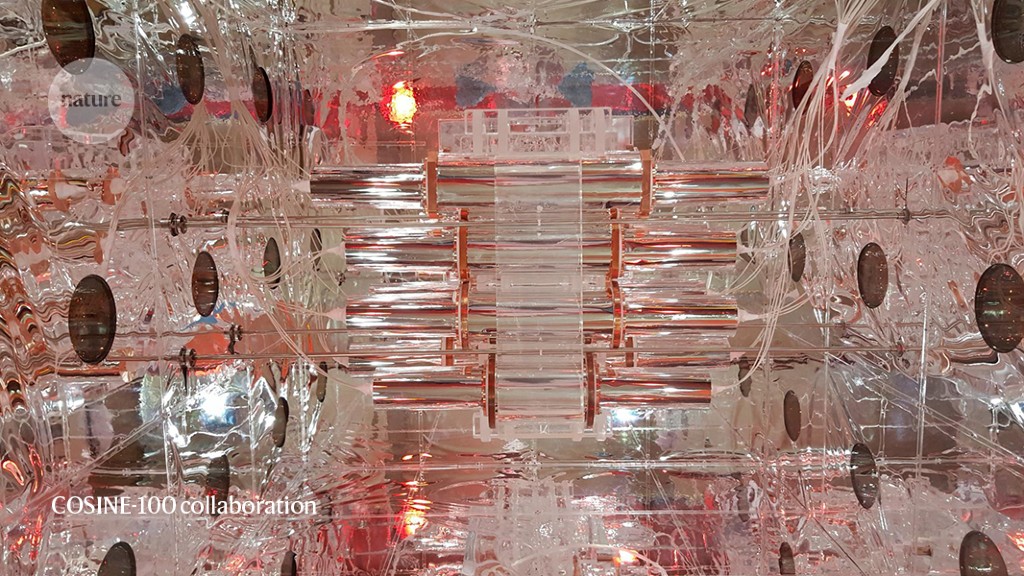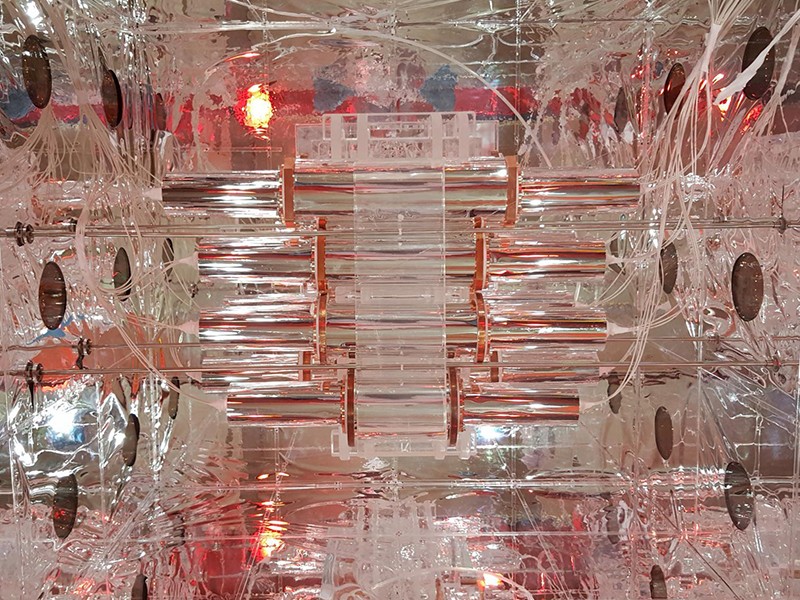Physicists have shown that an underground experiment in South Korea can ‘see’ dark matter streaming through Earth — or not, depending on how its data are sliced. The results cast further doubt on a decades-old claim that another experiment has been detecting the mysterious substance.
The latest study, published on the arXiv preprint server on 10 August1, reports that a certain type of data analysis by the COSINE-100 detector can produce seasonal fluctuations in the results. Physicists had proposed a similar fluctuation as a signature of dark matter, the invisible but pervasive stuff thought to be five times more abundant in the Universe than ordinary matter.
“If you apply the wrong method, you can see a fluctuation in their data where there wasn’t one,” says Nicola Rossi, an experimental particle physicist at the Gran Sasso National Laboratory near L’Aquila, Italy, who first suggested this explanation in 20202.
Dark-matter signal
For more than two decades, the experiment now known as DAMA/LIBRA, which is also at the Gran Sasso National Laboratory, has been reporting yearly fluctuations in flashes registered by the sodium iodide crystals of its detector3. The number of these events peak in June and bottom out in December, just as physicists would expect if particles of dark matter are suffusing the Milky Way. That’s because, as Earth orbits the Sun, its velocity in the Galaxy peaks in June, so that more particles from the dark-matter halo would hit the DAMA/LIBRA detector at that time — just as greater numbers of flying insects hit a car’s windscreen when the car moves faster.
But none of the many other dark-matter experiments — based on various other technologies — has so far seen signals compatible with DAMA/LIBRA’s. So, to put the claim to the ultimate test, in the mid-2010s, physicists began to build detectors made of the same type of sodium iodide crystal. Preliminary results from two of these experiments, COSINE-100 Yangyang underground laboratory in South Korea and ANAIS-112 at the Canfranc Underground Laboratory in the Spanish Pyrenees, failed to reproduce the windscreen effect.
Even though most of the physics community had discounted the DAMA/LIBRA results as probably spurious, the question of why the Italian experiment was seeing a periodic up-and-down in its recorded events remained. Over the years, the collaboration has convincingly rebuffed a number of proposed explanations.
Changing background
In 2020, while reading papers by the DAMA/LIBRA collaboration, Rossi and his colleagues noticed that the fluctuations reported were only those that occurred over a supposed ‘background’ of events that the team discounted as experimental artefacts, such as sources of radioactivity in the laboratory or in the detector itself.
But unless the background was absolutely constant throughout the year, this could be “a dangerous approach”, Rossi and his co-authors wrote. The windscreen effect should add a sinusoidal term to the background. But the precise way in which a background is modelled and subtracted could affect how the data are interpreted, and potentially create a spurious dark-matter signal.
To subtract the background flashes, the DAMA/LIBRA team averaged them out over every year, which could have made the number of remaining events look like a sawtooth wave. And because real-life data points are noisy, it could be easy, Rossi and his colleagues wrote in their 2020 report, to confuse the fluctuations with the type of sine wave expected from dark matter. The researchers also used simulated data to show that they could create a fake dark-matter signal if the number of background flashes was slowly increasing over time.
Result recreated
The COSINE-100 collaboration has now carried out a similar analysis of the real-world data collected by its crystals. “We can generate a DAMA-like signal with our analysis, but our timing is the opposite direction,” says Hyun Su Lee, a physicist at the Institute for Basic Science in Daejeon, South Korea, who is a co-leader of COSINE-100. In other words, as the backgrounds at the South Korea-based experiment naturally abate, its ‘dark matter’ count is highest around early December and lowest around early June.
This leaves a dilemma. Dark-matter detectors and other physics experiments must often contend with impurities in their radioactive materials, but as these age and the radioactive isotopes decay away, the background tends to become quieter, not louder. “Increasing background is pretty unnatural,” says Lee. Still, Rossi and his team suggest that some effects, such as radioactive impurities slowly creeping into the detector from outside, could, in principle, cause an increasing-background effect.
Either way, that the data analysis created a spurious fluctuation “strikes me as a potentially good — and maybe even likely — explanation” for the DAMA/LIBRA claims, says Dan Hooper, a specialist in dark-matter theory at the University of Chicago in Illinois.
Because the DAMA/LIBRA detector was built decades ago and has been kept underground ever since, radioactive backgrounds are more stable than in recently-built experiments, says Rita Bernabei, a physicist at the Tor Vergata University of Rome and spokesperson for DAMA/LIBRA. “If any small hypothetical contribution from a decreasing rate were there, it might decrease the observed modulation amplitude, but it would never produce positive signal as we observe,” she adds. The collaboration has also rebuked Rossi’s group’s arguments in a paper4 that calls their assumptions “untenable” and their conclusions “worthless”.
The physics community has repeatedly called on the DAMA/LIBRA team to reveal more of its data and, in particular, to provide the total counts of flashes. Bernabei says this “does not add any useful information.” But the added transparency could work to the collaboration’s advantage, says Rossi: if the full background count does turn out to be constant in time, it would add credibility to the team’s claim of seeing a sinusoidal fluctuation. “If the DAMA collaboration had been more open, this could have been figured out a long time ago,” says Hooper.
Meanwhile, attempts to replicate the dark-matter detections press on. Earlier this month, ANAIS-112 completed five years of data collection and is working on an analysis, says spokesperson Maria Luisa Sarsa of the University of Zaragoza in Spain. The data are sensitive enough that they could potentially exclude the DAMA/LIBRA result with a high statistical confidence. In a few years, that confidence could rise to five standard deviations, which is commonly the threshold for a physics result to be considered solid.








More News
Judge dismisses superconductivity physicist’s lawsuit against university
Future of Humanity Institute shuts: what’s next for ‘deep future’ research?
Star Formation Shut Down by Multiphase Gas Outflow in a Galaxy at a Redshift of 2.45 – Nature